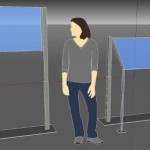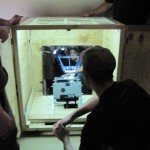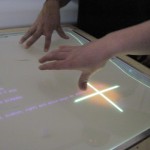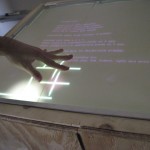
Multi-touch surface for UNK’s Computer Science department
While an undergraduate at the University of Nebraska at Kearney, I spent some a good deal of time researching, constructing and learning about programming for DIY multi-touch surfaces. To me, multi-touch surfaces represent a shift in casual computing workflows away from traditional desktop machines (keyboards, mice, screens, etc) and towards more natural methods of interaction that are more aligned with the way we communicate with each other and objects in our common environments.
First FTIR prototype
Although this post will primarily focus on the latest multi-touch surface, I actually constructed a prototype FTIR surface before this blog was created. With help from Philip Lempke and Jess Bazer, a wooden enclosure approximately {dimensions} in size was built, inside which is an adjustable mirror, projector and camera assembly. On top of the enclosure was a sheet of Endlighten acrylic with strips of IR LEDs on it’s edges.
This original prototype took a considerable amount of research, effort and work to construct, but as any experienced maker will tell you, that’s where the real learning happens! Ultimately, the surface was not successful, and was disassembled in favor of a more simple, modern design.
Lessons learned from the first FTIR surface
New LLP prototype
 Following the completion of the original FTIR prototype, I knew that there were many improvements to make. However, there were so many improvements needed that it seemed just as viable to construct a new multi-touch surface using the experience I gained from the first prototype. The most important lesson required a fundamental re-design of the system used to illuminate users’ fingers as they touch the surface. Essentially, where the old system used IR LEDs shining through the surface, the new system would use IR lasers shining just over the top of the surface. Much more detailed information about this technique can be found here:
Following the completion of the original FTIR prototype, I knew that there were many improvements to make. However, there were so many improvements needed that it seemed just as viable to construct a new multi-touch surface using the experience I gained from the first prototype. The most important lesson required a fundamental re-design of the system used to illuminate users’ fingers as they touch the surface. Essentially, where the old system used IR LEDs shining through the surface, the new system would use IR lasers shining just over the top of the surface. Much more detailed information about this technique can be found here:
Sensing technology of the new multi-touch surface
Design of the new surface
 The design of the multi-touch surface is heavily influenced by the minimalistic design of the töken multi-touch surface, which greatly simplifies a lot of the problems we had with the original FTIR surface, such as heat management and projector alignment.
The design of the multi-touch surface is heavily influenced by the minimalistic design of the töken multi-touch surface, which greatly simplifies a lot of the problems we had with the original FTIR surface, such as heat management and projector alignment.
Once the design of the surface was decided upon, I created construction plans and handed them off to Lederman’s Steel in Kearney. The pieces were fabricated and sent off to ACE Irrigation for a powder coat, to protect the steel from rusting. At this point, I took some time to figure out what the next steps were and plan out how to attach the acrylic surface and lasers to the frame.
At this point, Adam Zheng and Tyler McConville stepped in and helped a great deal to calibrate the lasers and learn about how the system works. Since I was about to graduate, I thought it best to have at least someone in the department who knows how to set up and calibrate the system for normal use! They eventually got the system up and running, and ready to run custom multi-touch programs.
Programming for the surface
At the time of construction for this surface, the standard tools used to get useful data from the multi-touch system was through the paired use of a webcam tracker program like Community Core Vision (CCV) and a client program that implements the TUIO protocol. Much more information about programming for multi-touch surfaces such as this one can be found here:
Everything you need to know to begin
developing multi-touch applications
Demonstration
During the Spring 2011 offering of my course, Interactive and Generative Art (CSIS 495), Tyler McConville developed one of the first multi-touch programs for our system as his final project. He chose to create a simple touch-based color-mixing program that allowed users to drag various translucent circles around the screen and overlap them to create new colors. His program was debuted at the 2011 Interactive and Generative Art Exhibition.


